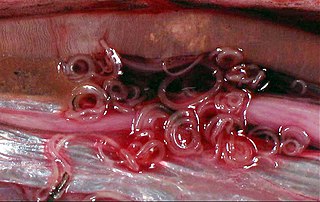Leptosomatidae is a family of benthic marine nematode worms.

Enoplea (enopleans) is a class, which with the classes Secernentea and Chromadorea make up the phylum Nematoda in current taxonomy. The Enoplea are considered to be a more ancestral group than the Chromadorea, and researchers have referred to its members as the "ancestrally diverged nematodes", compared to the "more recently diverged nematodes" of Chromadorea.

Cirrina or Cirrata is a suborder and one of the two main divisions of octopuses. Cirrate octopuses have a small, internal shell and two fins on their head, while their sister suborder Incirrina has neither. The fins of cirrate octopods are associated with a unique cartilage-like shell in a shell sac. In cross-section, the fins have distinct proximal and distal regions, both of which are covered by a thin surface sheath of muscle.

Secernentea was a class of nematodes in the Classical Phylogeny System and is no longer in use. This morphological-based classification system has been replaced by the Modern Phylogeny system, where taxonomy assignment is based on small subunit ribosomal DNA.

The Bifidobacteriaceae are the only family of bacteria in the order Bifidobacteriales. According to the 16S rRNA-based LTP release 106 published by 'The All-Species Living Tree' Project, the order Bifidobacteriales is a clade nested within the suborder Micrococcineae, also the genus Bifidobacterium is paraphyletic to the other genera within the family, i.e. the other genera are nested within Bifidobacterium.

The Chromadorea are a class of the roundworm phylum, Nematoda. They contain a single subclass (Chromadoria) and several orders. With such a redundant arrangement, the Chromadoria are liable to be divided if the orders are found to form several clades, or abandoned if they are found to constitute a single radiation.

Ochrophytes are the photosynthetic stramenopiles, a group of eukaryotes characterized by the presence of two unequal flagella, one of which has tripartite hairs called mastigonemes. Ochrophytes are one of the most diverse lineages of eukaryotes, containing ecologically important algae such as brown algae and diatoms. They are classified either as phylum Ochrophyta or subphylum Ochrophytina within phylum Gyrista. Their plastid is of red algal origin.

The nematodes, roundworms or eelworms constitute the phylum Nematoda. They are a diverse animal phylum inhabiting a broad range of environments. Most species are free-living, feeding on microorganisms, but there are many that are parasitic. The parasitic worms (helminths) are the cause of soil-transmitted helminthiases.

Bigyra is a phylum of microscopic eukaryotes that are found at the base of the Stramenopiles clade. It includes three well-known heterotrophic groups Bicosoecida, Opalinata and Labyrinthulomycetes, as well as several small clades initially discovered through environmental DNA samples: Nanomonadea, Placididea, Opalomonadea and Eogyrea. The classification of Bigyra has changed several times since its origin, and its monophyly remains unresolved.
Conserved signature inserts and deletions (CSIs) in protein sequences provide an important category of molecular markers for understanding phylogenetic relationships. CSIs, brought about by rare genetic changes, provide useful phylogenetic markers that are generally of defined size and they are flanked on both sides by conserved regions to ensure their reliability. While indels can be arbitrary inserts or deletions, CSIs are defined as only those protein indels that are present within conserved regions of the protein.
Dorylaimia is a subclass of nematodes.
The Enoplia are a subclass of nematodes in the class Enoplea.
Longidoridae is a family of polyphagous root ectoparasites in the phylum Nematoda (nematodes) with a worldwide distribution.
Ingenia is a genus of marine nematode worms native to Brazil, with a single known species, I. mirabilis. It belongs to the Tripyloididae, which is a group that are mostly free-living and which feed on diatoms and other algaes.
Paratrichodorus is a genus of terrestrial root feeding (stubby-root) nematodes in the Trichodoridae family (trichorids), being one of five genera. They are economically important plant parasites and virus vectors. The females are didelphic, and are distributed worldwide.
Triplonchida is an order of terrestrial nematodes, and is one of two orders making up the subclass Enoplia.
Diphtherophorina is a suborder of terrestrial nematodes, being one of three that constitute suborder Triplonchida.
Trichodoridae is a family of terrestrial root feeding nematodes, being one of two that constitute suborder Triplonchida. They are economically important plant parasites and virus vectors.

Trichodorus is a genus of terrestrial root feeding (stubby-root) nematodes in the Trichodoridae family (trichorids), being one of five genera. They are economically important plant parasites and virus vectors.
Aphelenchus is a genus of nematode in the family Aphelenchoididae. Member species inhabit soil and feed on fungi.








